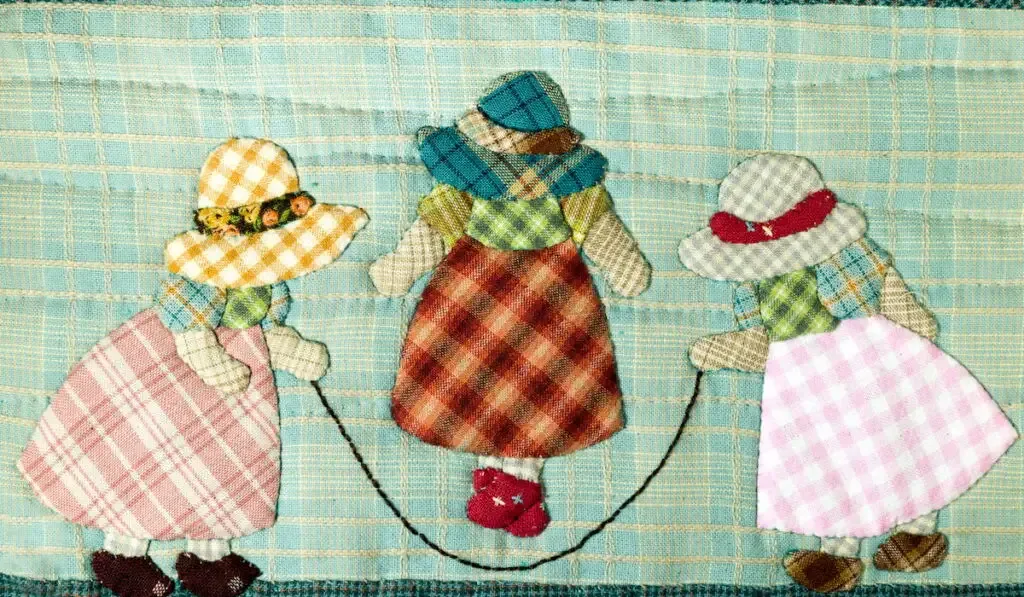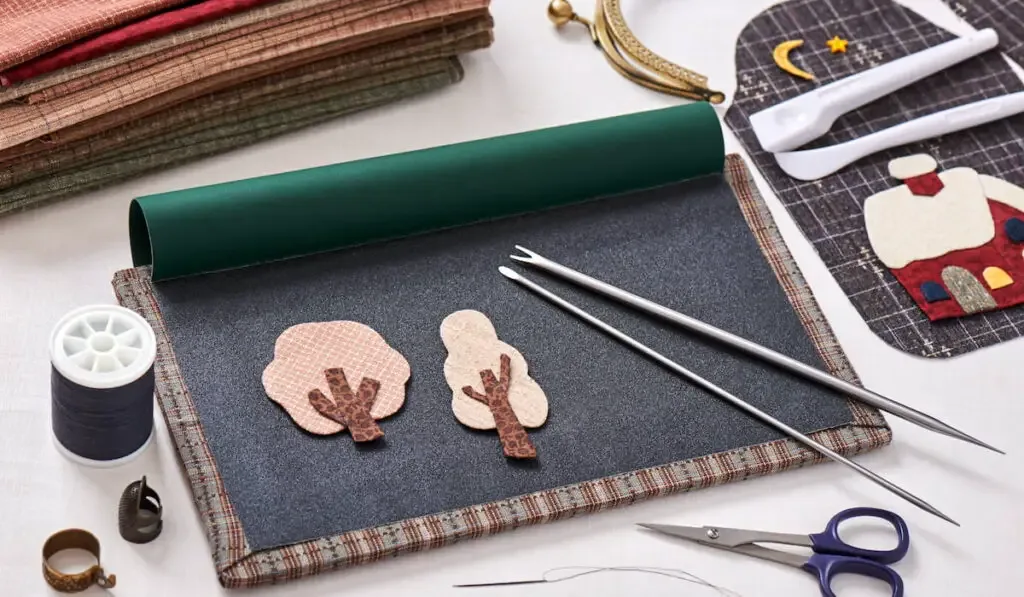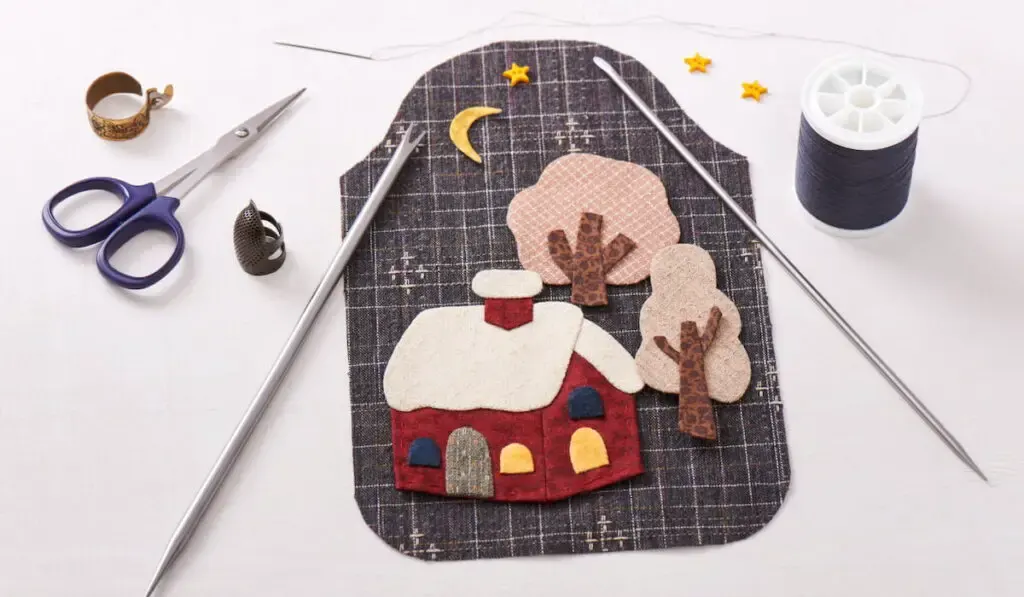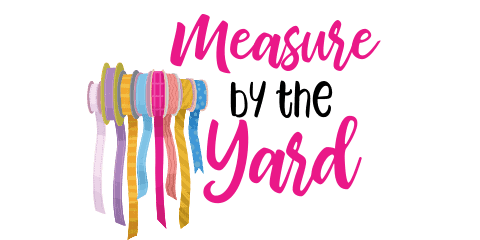Applique and patchwork share some similarities. So, if you are new to quilting, it isn’t surprising if you confuse them for each other. But while they might be similar in some ways, appliques and patchwork are very different. In this article, we will clarify the differences.
What is the difference between applique and patchwork?
The primary difference between applique and patchwork is the background fabric. When you do patchwork, you sew smaller fabric pieces together. But when you make an applique, you sew smaller fabric pieces onto larger fabric.

If you intend to try out applique or patchwork, we have some information that might help your new adventure. Below, we discuss the key differences between applique and patchwork.
Beyond that, we explain the different styles of each technique and talk about much more.
Difference Between Applique and Patchwork
Applique involves joining smaller pieces of fabric together by sewing them onto a larger fabric.
On the other hand, patchwork, also known as piecework, involves sewing smaller pieces of fabric together.
The difference is that applique uses a large fabric as the background, while patchwork needs no background fabric.
You could think of it this way: applique is decorative while patchwork is functional. With patchwork, you add smaller-sized fabric pieces to create something. But with applique, you sew smaller-sized pieces of fabric on a larger fabric to design the larger fabric.
How Applique and Patchwork Are Similar
As we said earlier, applique and patchwork share some similarities. This is why people may confuse them for each other. Patchwork and applique share the similarity of using smaller pieces of fabric. Both are also ancient techniques, and you can use both in quilting.
Applique
Traditionally, people made applique using felt, fleece, and quilting cotton. However, these days, you can use many other types of fabrics. Unlike patchwork, you do not have to sew so many fabric pieces together when making an applique.
The canvas (background fabric) is the primary fabric, so the smaller-sized pieces of fabric only form a pattern on it. In some cases, people do not even use smaller-sized fabric pieces for the patterns. Some people now use beads, buttons, sequins, and other decorative items.

Types of Applique
While all types of applique involve stitching smaller fabrics on a canvas (background fabric), they differ in some ways. Below are 5 types of applique and their description:
- Smooth edge applique
- Raw edge applique
- Multi-needle hoop applique
- Reverse applique
- Decorative stitch applique
Smooth Edge Applique
Smooth edge applique is pretty popular amongst enthusiasts. To make smooth edge applique, you have to trim and clean off the raw edges of the small fabric pieces without really changing them.
Raw Edge Applique
Raw edge applique is the opposite of smooth edge applique. In this type of applique, you leave the edges of the cut pieces of fabric the way they are. Raw edge applique is typically applied in smaller projects.
Multi-Needle Hoop Applique
Multi-needle hoop applique is a machine technique achieved using embroidery hoops. You create your design pattern on the canvas. Then you hoop stitch each piece of cut fabric onto the designs. When done stitching the fabric pieces onto the canvas, they will fit into the patterns perfectly. So, you don’t have to realign them.
Reverse Applique
In reverse applique, you will sew fabrics on each other. After that, you will cut the top layer of fabric layers to reveal the design. For instance, to do reverse applique, you could sew 2 layers of fabric on each other. Then you cut a heart shape into the top layer, revealing a heart-shaped portion of the bottom layer as the design.
Decorative Stitch Applique
Decorative stitch applique is just as the name says. Instead of making applique with fabric pieces, you use decorative stitches. You may make the decorative stitches by hand or with a sewing machine.
When making decorative stitches with a sewing machine, you can choose from various stitch types. But you may want to start with a zig-zag stitch as it can give your design a smooth edge.
When making the stitches with your hand, you may use the needle-turn technique. It gives the applique a sleek, 3-dimensional finish.

Methods of Applique
You can make appliques in various ways. But the following are the 3 most common methods:
- Hand Embroidery
- Fusing
- Machine Embroidery
Hand Embroidery
One common technique used when making applique using hand embroidery is the needle-turn technique. It may be popular, but it might take a while to get used to the said technique.
Hand embroidery offers flexibility when making applique. You can add embellishments as you want, and you can switch stitch patterns easily.
However, using hand embroidery for applique making is pretty tedious and time-consuming. Also, getting a nice finish might be tough if you do not have enough experience with hand stitching. You may also find it hard to handle some robust fabrics.
Fusing
Unlike hand embroidery, fusing offers a faster way to attach fabric pieces to the canvas fabric. Fusing involves attaching the fabric pieces to the canvas using a fusible web. A fusible web is an adhesive fiber that melts on ironing. You place it between the fabric pieces and the canvas fabric then you iron them together to stick.
Since fusing does involve stitching, it is faster than the hand embroidery method. However, it may not last as long as hand embroidery or machine embroidery.
Machine Embroidery
At the simplest, machine embroidery is hand embroidery achieved with a sewing machine. It is faster than hand embroidery and lasts longer than fusing.
Machine embroidery also offers you a range of stitches and pre-cut shapes to work with. So, if you are a beginner, this method is a fair way to start.
Patchwork
The small pieces of fabric used in patchwork are known as patches.
When doing patchwork, no rules guide how you attach the patches together. You can attach the patches in various shapes, including triangles, rectangles, hexagons, and squares.
You can also follow a random pattern. Also, when doing patchwork, you can work with pretty much any type of fabric. But if you want, you can work with identical patches to create a pattern.
Types of Patchwork
There are various types of patchwork, and as you quilt, you will come to know more of them. However, before that time comes, the following are some types of patchwork:
One Patch
Quilters repeat the same shape, creating a pattern in the final product to get one patch.
Four Patch Blocks
This type of patchwork uses 4 different fabric pieces. The fabrics can be of the same shape or varying shapes, and quilters arrange them in multiple segments to make the patchwork.
Five Patch Blocks
Unlike the four patch blocks, the five patch blocks do not use 4 patches. Instead, the five patch blocks use 25 patches. Quilters sew 5 patches per row and 5 per column to make five patch blocks.

Methods of Patchwork
After cutting the fabric pieces for patchwork, you can attach them using various methods. Some of them include:
- Chain piecing
- Strip piecing
Chain Piecing
Chain piecing is the most commonly used method for making patchwork. It involves sewing straight edge patches with your hands or a machine before sewing the straight edge patches together using backstitches.
Strip Piecing
Strip piecing is a quick method for making patchwork. It involves sewing strips of fabric together then cutting them into smaller-sized segments needed for quilt blocks.
Can You Use Patchwork and Applique in the Same Quilt?
As previously mentioned, you can use patchwork and applique in making quilts. Also, if you want, you can use applique and patchwork in the same quilt.
Examples of quilts made with both patchwork and applique are not uncommon. So, you should have no issues finding something to work with.
Is Applique Easier Than Patchwork?
Well, the easier technique between applique and patchwork is pretty subjective. Some people do applique and find it easier than patchwork. Then again, some do patchwork and find it simpler than applique.
You may have to try both techniques and decide which is easier for you.

Is Applique Better Than Patchwork for Making Quilts?
The better technique for making quilts between applique and patchwork is something you may have to choose on your own.
When some quilters do patchwork, they find it easier and more suitable for their quilts. Contrarily, some people prefer the ease that comes with applique.
Resources
- https://sewingmachinetalk.com/the-difference-applique-patchwork/
- https://www.mrxstitch.com/difference-patchwork-applique/
- https://sewingandquiltingclub.com/difference-between-applique-and-patchwork/
- https://www.kreativekiwiembroidery.co.nz/blog/Large-Applique-Hints.html
- https://thequiltshow.com/quiltipedia/what-are-decorative-stitches
- https://thequiltshow.com/quiltipedia/what-is-strip-piecing
